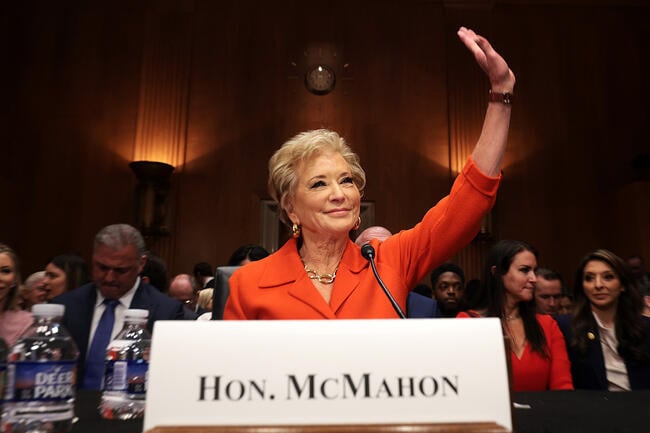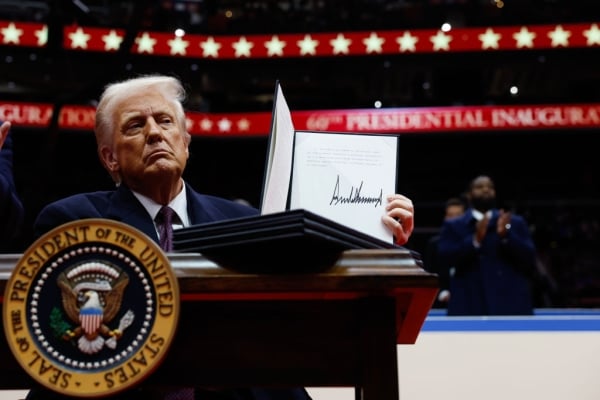Trump Signs Order to Break Up Education Department

The Trump administration has already laid off nearly half of the staff at the Education Department.
Win McNamee/Getty Images
After weeks of rumors and one false start, President Donald Trump signed the long-awaited executive order on Thursday directing Education Secretary Linda McMahon to close down her department “to the maximum extent appropriate and permitted by law.”
The order won’t result in the immediate closure of the 45-year-old agency; only Congress can get rid of the department. But White House Press Secretary Karoline Leavitt told reporters Thursday that the aim is to reduce the size of the agency but still administer “critical functions.” So, the department will continue to enforce civil rights laws, issue student loans and disburse Pell Grants, among other functions, Leavitt said.
The final order, which Trump signed during a ceremony that included several Republican governors and other key lawmakers, appears to be largely similar to a draft version that Inside Higher Ed obtained earlier this month. That draft called for McMahon to “return authority over education to the states and local communities,” though it doesn’t specify what that actually means or how that process would work. Neither Trump nor McMahon have outlined a plan for closing the department—a process that experts say would be lengthy and complex, even if Congress signs off.
Most Popular
“Everybody knows it's right,” Trump said at the ceremony. “We're going to shut it down and shut it down as quickly as possible.”
Even without an executive order, McMahon, who sat in the front row Thursday and has backed dismantling the agency, has started to gut the department. Last week, she laid off nearly half of the agency’s more than 4,000 employees. The mass layoffs eliminated entire offices, while others such as the National Center for Education Statistics were left with a skeletal crew, raising questions about whether the department can actually fulfill key functions.
The layoffs and other cuts at the agency to federal grants and contracts have left department employees feeling a sense of dread about the future. Other higher education advocates have warned abolishing the agency could be catastrophic for institutions and students and others who rely on the department.
Shuttering the department is unpopular with voters, multiple recent surveys have found. In a poll from Morning Consult, a data-driven insights company, a majority of respondents supported either preserving or increasing the department’s funding.
It’s unclear what impact the order will have in practice; but, the White House will likely trumpet the move as another promise kept by Trump, who pledged on the campaign trail to abolish the department. Trump and other Republicans have argued that the department is ineffective, unconstitutional and a symbol of federal overreach. Reducing the department’s footprint in K-12 and higher education will test the theories of the several conservative experts who say the agency is unnecessary.
McMahon said in a statement after the order was signed that closing the department won't mean “cutting off funds from those who depend on them—we will continue to support K-12 students, students with special needs, college student borrowers, and others who rely on essential programs.”
McMahon pledged to follow the law and work with Congress and state leaders “to ensure a lawful and orderly transition,” adding that students “will be relieved of the drudgery caused by administrative burdens—and positioned to achieve success in a future career they love.”
Florida governor Ron DeSantis said “good riddance” to the agency this week in a Wall Street Journal op-ed, adding that abolishing the department would remove “cumbersome bureaucracy” and lead to “educational excellence.” He was one of several Republican state leaders who attended the ceremony Thursday.
“For decades, the federal government has tied more strings than ever imaginable to our federal education dollars for both secondary and postsecondary education,” he wrote. “Under the last administration, these requirements went beyond burdensome and required DEI measures to be used at every turn, a perfect example of bureaucratic red tape that was hindering progress.”
Other Republican lawmakers and state executives applauded the Trump administration’s actions, saying it’s due time to return power to the states.
“The key to improving education is empowering parents and students and reducing the role of Washington bureaucrats,” Rep. Tim Walberg, a Michigan Republican and chair of the House Committee on Education and the Workforce, said in a statement.
Editors' Picks
Likewise, Lindsey Burke, director for the Center for Education Policy at the Heritage Foundation, called the order a “tremendous step toward restoring education control to states, localities and parents.”
“Congress must now follow the President’s lead and take the steps necessary to permanently dismantle what Ronald Reagan called Carter’s ‘bureaucratic boondoggle,’” she said in a statement to Inside Higher Ed.
Much of the criticism about the department relates to K-12 education. For instance, a White House email ahead of the signing ceremony said the department has “spent over $3 trillion with virtually nothing to show for it,” pointing to students’ standardized test scores that show declines in math and reading proficiency.
But the department plays a key role in overseeing and funding higher education, and experts worry that cutting the agency could be disruptive for institutions and the students they serve.
Ted Mitchell, president of the American Council on Education, a leading higher ed lobbying group, said in a statement that the order “is political theater, not serious public policy.”
“The administration and Congress should focus on improving on the important work that the department performs that benefits ordinary Americans, not unilateral and thoughtless cuts to the department’s workforce and ability to serve Americans,” Mitchell added.
Other advocates for students and borrowers as well as Democratic lawmakers at the state and federal level decried the order as “reckless” and “heartless.”
Sen. Patty Murray, a Democrat from Washington state, said in a statement that wrecking the department will make it “harder for students to get help getting financial aid, jeopardizing the funding schools and families count on every day.”
She added that Trump knows he can’t abolish the department, “but he understands that if you fire all the staff and smash it to pieces, you might get a similar, devastating result.”
“The billionaires running our government may not understand why federal financial aid or funding for working class school districts or watchdogs protecting students from scammy for-profit colleges matters—but the constituents I talk to every day do, and they are not sitting quiet while Trump seeks to destroy public education in America,” she said.
Aaron Ament, president of Student Defense, a national legal advocacy network, said his group was preparing to go to court to stop the dismantling of the department.
“The notion that the Department can be summarily closed or functionally decimated while maintaining ‘uninterrupted delivery of services, programs and benefits on which Americans rely’—as the order reportedly directs—is a pipe dream,” he said in a statement ahead of the signing ceremony.












